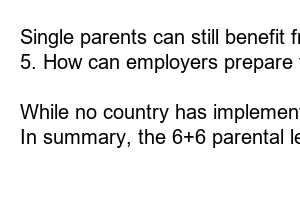6+6 부모육아휴직제
Title: The 6+6 Parental Leave System: Striving for Equality and Work-Life Balance
Introduction:
In recent years, there has been a growing recognition of the importance of parental leave in supporting families and enhancing work-life balance. One promising approach gaining traction is the 6+6 parental leave system. This blog post intends to provide a comprehensive overview of this system, explaining its benefits, implications, and practical implementation.
1. What is the 6+6 Parental Leave System?
The 6+6 parental leave system grants both parents six months of dedicated leave each after the birth or adoption of a child. Unlike traditional parental leave policies, which often prioritize mothers, this system acknowledges the value of both parents’ involvement in childcare responsibilities.
2. Promoting Parental Equality:
By instituting equal leave entitlements for both parents, the 6+6 system encourages greater gender equality in childcare. It enables fathers to take on a more active and nurturing role, fostering bonding and allowing mothers a chance for self-care and career growth.
3. Work-Life Balance Benefits:
Achieving work-life balance is a perpetual challenge for working parents. The 6+6 system offers an extended period for parents to fully support and care for their child’s critical early milestones. It allows parents to establish routine, adapt to new roles, and ultimately return to work with greater confidence and focus.
4. Positive Impact on Gender Pay Gap:
Gender pay disparity is a persistent issue worldwide. The implementation of the 6+6 parental leave system has the potential to reduce the gender pay gap. By ensuring that both parents have equal opportunities to prioritize their careers and family life, it helps diminish gender-based discrimination in the workplace.
5. Employer Adaptation:
While the benefits of the 6+6 system are evident, employers may be concerned about the impact on productivity or staffing. However, studies have shown that companies that support parental leave experience higher employee satisfaction, reduced turnover rates, and improved company reputation. Encouraging employers to embrace this system is thus imperative.
6. Practical Implementation:
Implementing the 6+6 parental leave system requires effective coordination among policymakers, employers, and employees. Comprehensive legislation and clear communication about eligibility, application, and return-to-work processes are crucial. Public awareness campaigns can also help change societal attitudes towards parental roles.
FAQs:
1. How does the 6+6 system benefit children?
The extended parental leave period allows for enhanced nurturing, developmental support, and stronger parent-child bonds.
2. Can the 6+6 system be adopted by any country?
While the system requires appropriate legislation and political will, it can be adapted and customized to suit each country’s unique social and economic context.
3. What happens if one parent does not wish to utilize their leave entitlement?
In such cases, their portion of leave can be transferred to the other parent, ensuring optimal flexibility and customization.
4. How does the 6+6 system address single-parent households?
Single parents can still benefit from extended leave under this system, encouraging their well-being and relationship building with the child.
5. How can employers prepare for the implementation of the 6+6 system?
Providing support programs, mentorship, flexible work options, and revising HR policies will help employers transition smoothly into this new framework.
6. Are there any countries that have already adopted the 6+6 system?
While no country has implemented the 6+6 system universally, various nations, including Sweden and Iceland, have favorable family-oriented policies showcasing elements of the 6+6 parental leave system.
In summary, the 6+6 parental leave system offers a progressive solution, promoting gender equality, work-life balance, and the overall well-being of families. Its implementation requires collaboration between governments, employers, and individuals to achieve a more inclusive and supportive society.

